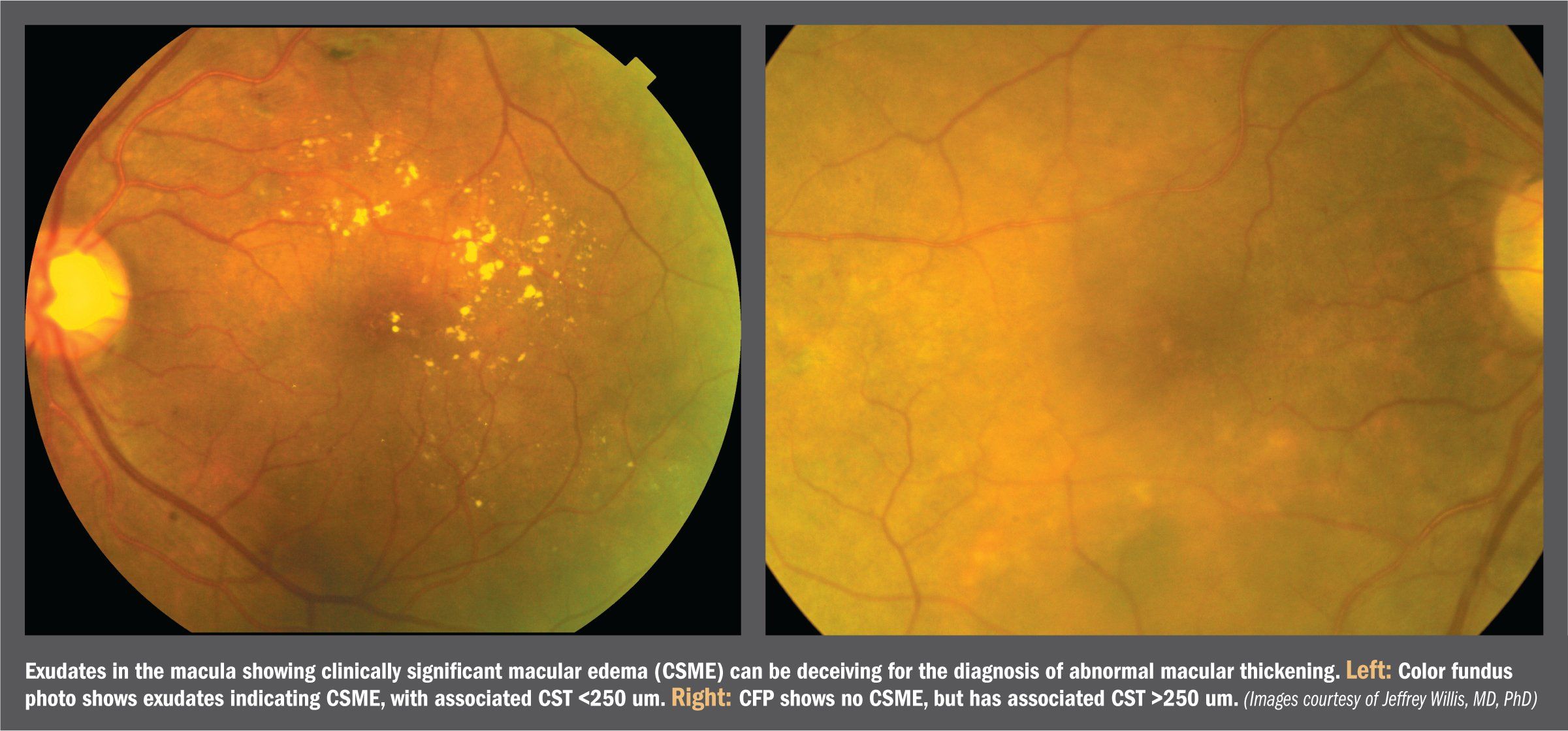Article
Deep learning predicts OCT measures of diabetic macular thickening
Author(s):
Study: AI can detect swelling, severity of that swelling in macula of patients with diabetes

Deep learning is capable of automatically predicting OCT-equivalent measures of macula thickening from color fundus photos and could significantly benefit tele-ophthalmology.
Artificial intelligence (AI) is already proving useful for applications in telemedicine. In particular, the use of remote eye-screening methods is allowing access to care by patient populations that otherwise would not receive it.
The results of a study performed by Roche and Genentech scientists suggest that AI could be used to provide widespread, cost-effective eye screenings via telemedicine for millions of people with diabetes.1
“This study adds to the growing evidence that AI is a promising tool for ophthalmologists in identifying patients that need care,” said Jeffrey Willis, MD, PhD, associate medical director, ophthalmology at Genentech, and one of the study authors. “Additionally, this study underlines the potential of utilizing historical clinical trial databases to develop AI algorithms in ophthalmology.”
RELATED: What retinal specialists should know about their pregnant patients
DME screening
For diabetic macular edema (DME), the standard screening modality for diagnosis is optical coherence tomography (OCT), which provides three-dimensional, cross-sectional images of the macula on which swelling can be detected.
Due to cost and technology limitations, OCT is often not available in areas where telemedicine is being used, and the best images that can be captured are color fundus photographs (CFPs). Because CFPs are two-dimensional, it can be difficult to use them to determine the severity of DME.
The Roche/Genentech study demonstrated that AI-specifically deep learning (DL) technology-can detect swelling, and the severity of that swelling, in the macula in people with diabetes. The scientists showed that deep convolutional neural networks (DCNNs) can use CFPs to predict diabetic macular thickening (MT), similar to what would be seen on OCT scans.
RELATED: Mini quiz: Educating patients about DME
The primary objective of the study was to assess whether DL can automatically predict OCT-equivalent quantitative MT measures, using CFPs, and the secondary objective was to assess the robustness of a DL regression model to predict the exact value in micrometers of central foveal thickness (CFT) and central subfield thickness (CST).
The data
The researchers performed a retrospective analysis on 17,997 CFPs and their associated OCT measurements, taken from the phase III RIDE and RISE studies in DME, to develop and assess the performance of deep learning algorithms. Large amounts of data collected during clinical trials such as these are very valuable for developing AI algorithms. Results were presented relating to four different DCNN models:
- Two models to detect the presence of clinically significant MT, using the cutoff points on time-domain OCT (TD-OCT) of CFT of 250 μm and 400 μm
- Two models to detect the presence of clinically significant MT, using the cutoff points on TD-OCT of CST of 250 μm and 400 μm The authors say their study showed DL models can accurately identify which CFPs are associated with a clinically significant level of MT.
Results
The study showed that the best deep learning algorithm was up to 97% accurate in detecting DME severity using CFPs alone. These results show there is potential for AI to increase screening capacity via telemedicine, according to Genentech.
The authors point out there is a crucial difference between this study and prior studies looking at DL algorithms to detect DME, in that this study “aimed to predict actual quantitative OCT measurements from CFPs rather than being explicitly instructed to identify the presence of other DME markers such as exudates.”
They also found, as a tertiary objective, that the performance of the models was not as high when the models were trained on CFPs that included images that were of poor quality or had laser scars. The authors noted that training for the AI algorithm was based on data from clinical trials and therefore may not translate the same to the overall population with diabetes, and that their results might not apply to macular edema secondary to other causes.
Conclusion
According to this study, DL is capable of automatically predicting OCT-equivalent measures of MT from CFPs and could significantly benefit tele-ophthalmology screening programs, contributing to earlier diagnoses of abnormal MT, timely referral to specialists, faster recruitment of patients into clinical trials, and enhanced visual/health outcomes among individuals with diabetes.
RELATED: Determining DR progression: Much work still needs to be done
Disclosures:
Jeffrey Willis MD, PhD
E: willis.jeffrey@gene.com
Dr. Willis is associate medical director, ophthalmology, at Genentech and a study author.
References:
1. Arcadu F, Benmansour F, Maunz A, Michon J, Haskova Z, McClintock D, Adamis AP, Willis JR, Prunotto M. Deep learning predicts OCT measures of diabetic macular thickening from color fundus photographs. Investigative Ophthalmology & Visual Science. 2019;60:852-857. doi:10.1167/iovs.18- 25634.
Newsletter
Don’t miss out—get Ophthalmology Times updates on the latest clinical advancements and expert interviews, straight to your inbox.





